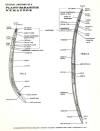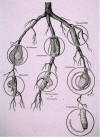
| Nematode Parasites of Higher Plants | Nematode Parasites of Animals and Humans |
Rev 10/30/2019
Plant parasitism evolved independently in
three traditional nematode orders, Dorylaimida Pearse 1942, Triplonchida Cobb 1920 (both Enoplea), and Rhabditida (Tylenchina Thorne 1949) (Chromadorea). In the Tylenchina, ribosomal RNA analysis suggests that plant parasites have evolved within clades that include many free-living nematodes (Baldwin et al, 2004). Insight from molecular phylogenies based on the nuclear small subunit ribosomal RNA indicate that the enoplean Dorylaimida and Triplonchida lack a common ancestor. Tylenchina shares a most recent common ancestor with Cephalobina (primarily bacteriovore Cephaloboidea). Triplonchida appears to be the sister clade to the Enoplida Filipjev, 1929 (primarily marine omnivores and bacteriovores), and Dorylaimida are embedded within a clade that includes insect parasites (Mermithida), vertebrate parasites (Trichinellida), and predators (Mononchida, and other Dorylaimida). It cannot be assumed that plant parasitism arose only once in each order (Baldwin et al, 2004).Within the Dorylaimida, the evolutionary origin of the Longidoridae is currently uncertain, however the genus Longidorella (Nordiidae) appears to have evolved from an omnivore ancestor while the evolutionary history of Pungentus is uncertain (Holterman et al. 2008).
Plant-feeding Nematodes of the Phylum Nematoda |
|||
Class Chromadorea |
Class Enoplea |
||
|
Rhabditida |
|||
|
|
|
|
|
| Classification by Functional Guild | |||
| Return to Main Menu | |||
Rhabditida
Suborder: Tylenchina
- dorsal esophageal gland opening (DEGO)
in procorpus
Three superfamilies:
- - pro/metacorpus amalgamated
- monovarial, no post-uterine sac
- no phasmids
- two families, both consist of plant parasites.
- four families, one or two with plant parasites.
Dorylaimida
Sub-order: Dorylaimina
- simple spear
- paired testes
- six superfamilies, one with plant parasites.
Superfamily: Dorylaimoidea
- smooth cuticle
- postcorpus wider
- monovarial or diovarial
- ten families, one with plant parasites.
Triplonchida
Sub-order: Diphtherophorina
Superfamily: Diphtherophoroidea
 |
| Drawings by Charles S. Papp, CDFA |
| 1.
Ectoparasites of plant roots a. Migratory b. Sedentary 2. Semi-endoparasites of plant roots a. Migratory b. Sedentary 3. Endoparasites of plant roots a. Migratory b. Sedentary |
4. Endoparasites of bulbs and
stems 5. Endoparasites of leaves 6. Endoparasites of seeds |
 |
||||||
Definitions:
|
||||||||
Commonalities
Ref: Bongers (1988), Ferris and Bongers (communication), Luc et al. |
||||||||
GeneralizationsPlant-feeding nematodes that have long bodies (>2mm):
|
||||||||
Community Structure of Nematodes Parasites of Higher Plants:Generalizations
Conversations among Ferris, Tom Bongers, Bart Verschoor, Ron de Goede. |
Baldwin, J.G., S.A. Nadler and B.J. Adams. 2004. Evolution of plant parasitism among nematodes. Ann. Rev. Phytopathol, 42:83-105.
Holterman et al. 2008. A ribosomal DNA-based framework for the detection and quantification of stress-sensitive nematode families in terrestrial habitats. Molecular Ecology Resources 8:23-34.
Return to Plant Parasites Menu